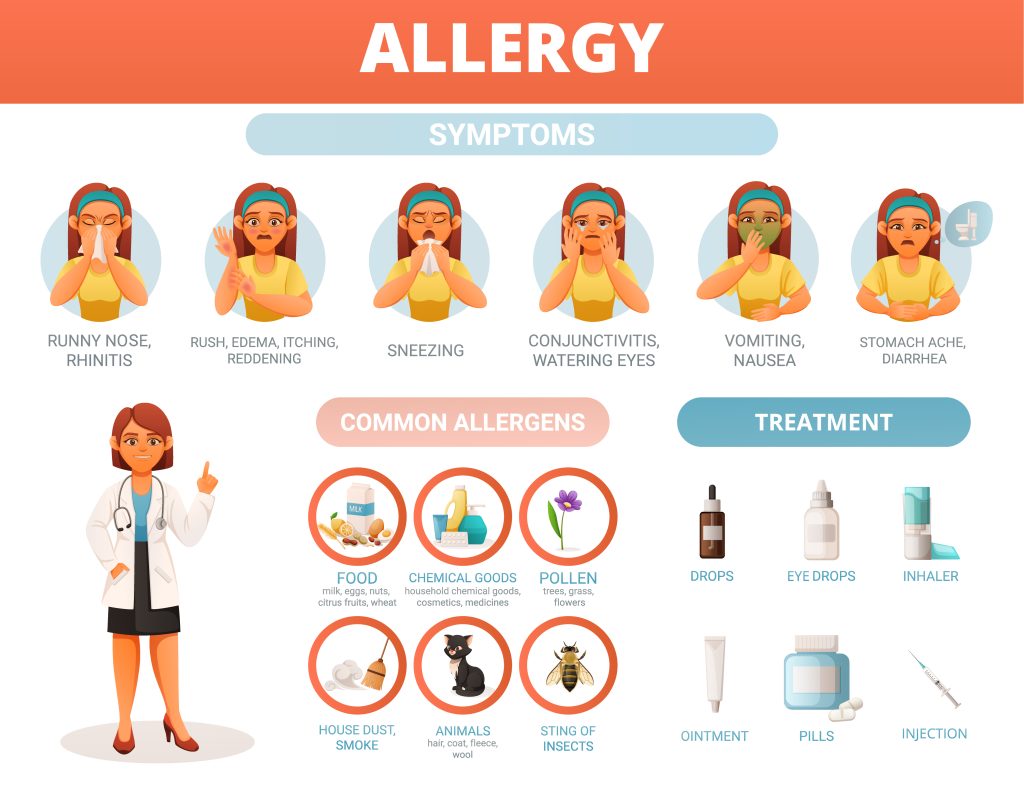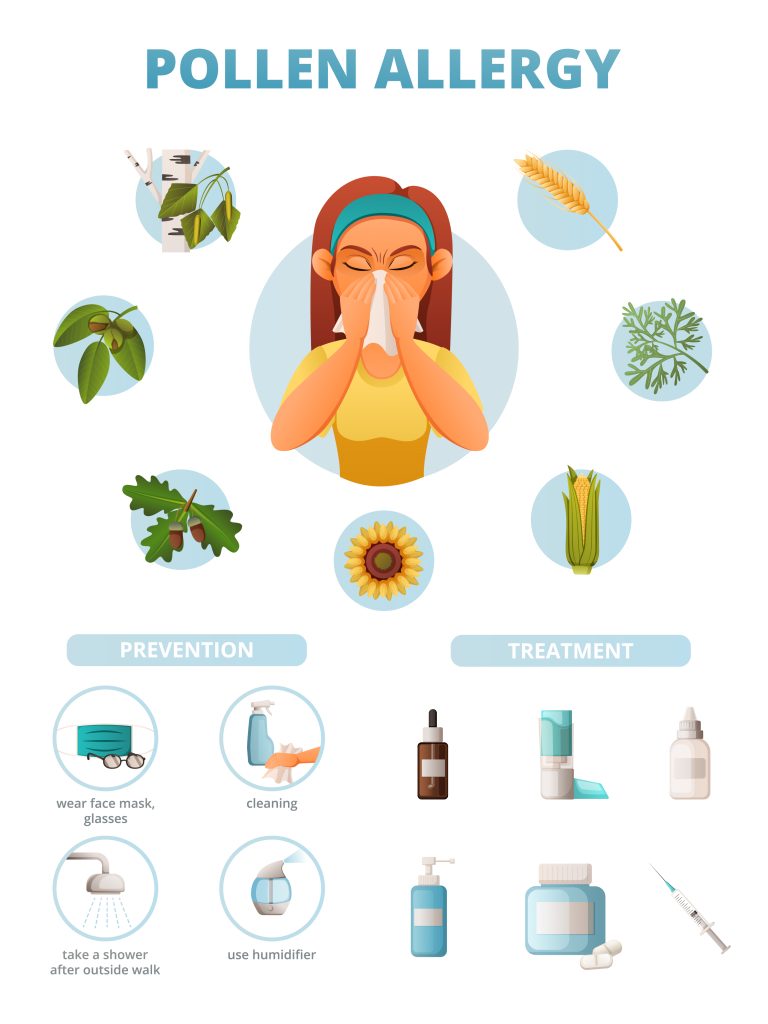According to this study, approximately 50 million Americans suffer from seasonal allergies yearly. Seasonal allergies affect millions worldwide, impacting their daily lives and overall well-being. As the seasons change, so do the prevalence and severity of allergic reactions.
That’s why we developed our seasonal allergies assessment tool. The tool is designed to assist individuals in identifying and managing seasonal allergy symptoms effectively. You’ll get information on whether you have suffered from seasonal allergies by answering a few straightforward questions.
Seasonal Allergies and Their Symptoms
Seasonal allergies result from an overactive immune response to harmless airborne substances. Histamines released by antibodies cause inflammation in the nose, eyes, throat, and lungs, leading to sneezing, runny nose, itchy eyes, sore throat, coughing, headache, fatigue, and more.
Symptom type and severity depend on allergen exposure, genetics, and environment. Mild symptoms may last days or weeks, while severe symptoms may persist for months or year-round. Allergic asthma, characterized by narrowed airways, is also possible.
Common Symptoms and Their Frequency
| Symptom | Frequency (%) |
|---|---|
| Sneezing | 85% |
| Runny or Stuffy Nose | 90% |
| Itchy or Watery Eyes | 70% |
| Itchy Throat | 60% |
| Postnasal Drip | 65% |
| Cough | 50% |
| Fatigue | 40% |
Common Causes of Seasonal Allergies

Common seasonal allergy triggers include pollen and mold. Pollen, produced by plants for reproduction, can enter your nose, mouth, or eyes through breathing or contact. Mold, a fungus found in damp places, releases spores that also trigger allergies.
Pollen seasons vary by region and plant type:
- Tree pollen: Spring (February to May), from sources like birch, oak, and maple.
- Grass pollen: Late spring to summer (May to August), from sources like timothy and Bermuda grass.
- Weed pollen: Late summer to fall (August to November), from sources like ragweed and sagebrush.
Importance of Early Assessment and Intervention for Seasonal Allergies
Assess and address seasonal allergies promptly by using our online Seasonal Allergies Assessment Tool. It helps identify allergens, manage symptoms, and follow guidelines from AAAAI and ACAAI.
Early intervention is crucial to effectively manage seasonal allergies, preventing complications like sinusitis, otitis media, asthma, and anaphylaxis. Untreated allergies may lead to chronic inflammation, damaging nasal passages, sinuses, ears, and lungs. Complications include pain, congestion, earache, hearing loss, balance problems, and severe allergic reactions. Also, try our Parenting Preteens – Separation Anxiety Disorder Assessment, offering support and strategies for parents dealing with separation anxiety in preteens.
Ways to Prevent Seasonal Allergies

Here are the tips and strategies for preventing and managing seasonal allergies:
- Limit outdoor activities: Especially during high pollen count times.
- Keep windows closed: To prevent pollen from entering the house.
- Use air purifiers: To remove allergens from indoor air.
- Wash hands and clothes: After being outdoors remove pollen.
- Saline nasal rinses: To flush out allergens from nasal passages.
- Monitor pollen counts: Check local pollen forecasts and plan activities accordingly.
Management Strategy Effectiveness
| Management Strategy | Effectiveness (%) |
|---|---|
| Antihistamine Medications | 70-90% |
| Nasal Corticosteroids | 80-90% |
| Decongestants | 70-80% |
| Allergen Immunotherapy | 85% |
| Avoidance | Varies |
| Air Purifiers | 60-80% |
| Saline Nasal Rinse | 50-60% |
| Eye Drops | 70-80% |
Always consult with a healthcare professional for diagnosis, treatment, and management of allergies. Our Seasonal Allergies Assessment can be a helping hand in detecting seasonal allergies to avoid the severity.
Natural Approaches & Supplements to Improving Your Health
This lists natural remedies and supplements that may help alleviate seasonal allergy symptoms:
- Butterbur: A herbal remedy known for its potential anti-inflammatory properties.
- Quercetin: A flavonoid with potential antihistamine effects.
- Local Honey: Contains trace amounts of local pollen, which may offer natural allergy relief.
- Probiotics: Beneficial bacteria that may help balance the immune response.
Action Guide for Emergencies
Firstly, recognize symptoms like difficulty breathing, swelling, rapid heartbeat, and dizziness. Then, use an epinephrine injector to administer epinephrine (EpiPen) as directed. Next, call emergency services by dialing 911 or your local emergency number. Finally, seek medical attention by going to the nearest emergency room for further treatment.
Common Complications of Allergies
Managing seasonal allergies can be challenging, but not impossible. There are many ways you can overcome the obstacles and improve your symptoms and quality of life. Here are some tips for managing seasonal allergies :
Avoid or reduce your exposure to allergens. This is the most effective way to prevent or lessen your symptoms. You can do this by:
- Check the pollen and mold counts in your area and stay indoors when they are high. You can find the latest information on websites such as Pollen.com or AirNow.gov.
- Keep your windows and doors closed during high pollen seasons and use air conditioners or air purifiers with HEPA filters to clean the air in your home and car.
- Showering, washing your hair, and changing your clothes after spending time outdoors to remove any pollen or mold that may have stuck to you.
- Avoiding activities that can stir up allergens, such as mowing the lawn, raking leaves, or gardening. If you have to do these tasks, wear a mask, gloves, and goggles to protect yourself.
- Keeping your pets indoors or bathing them regularly to reduce the amount of animal dander and pollen they may carry into your home.
Seasonal allergies are a common and bothersome condition that can affect your health and well-being in many ways. However, with early assessment and intervention, you can manage your allergies effectively and prevent them from getting worse or causing complications. Early assessment and intervention are crucial to prevent complications and improve quality of life. Individuals can better manage their seasonal allergies and enjoy a healthier lifestyle by taking proactive steps to avoid allergens and utilizing resources like our assessment tool.
Additional Resources
- AAAAI stands for American Academy of Allergy, Asthma, and Immunology
- ACAAI stands for American College of Allergy, Asthma, and Immunology
Related Calculators
